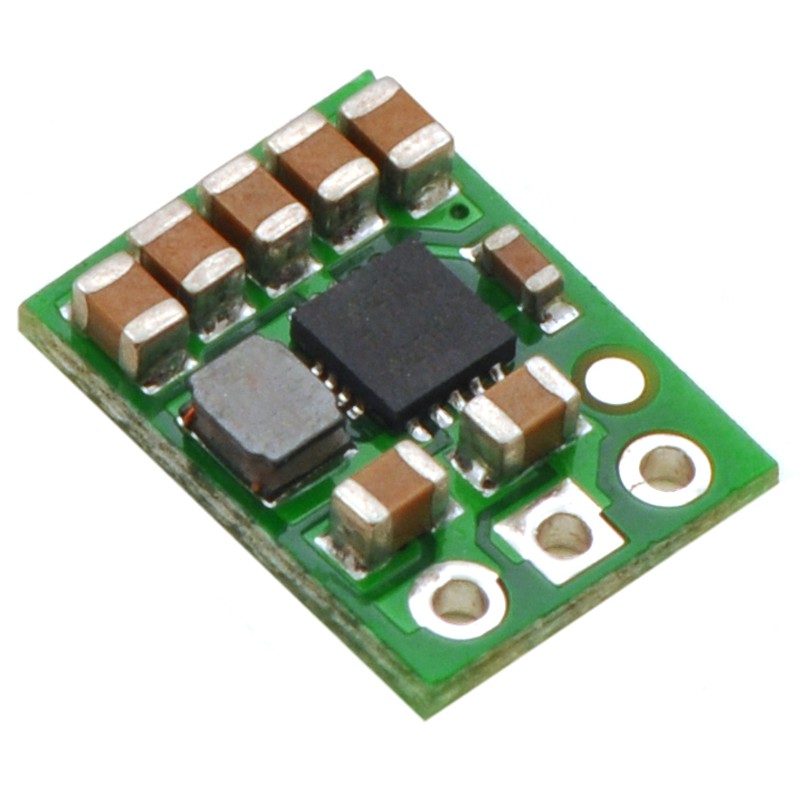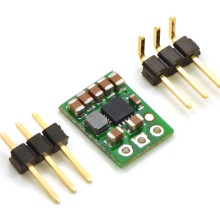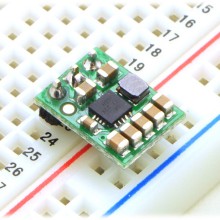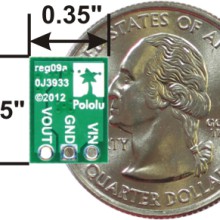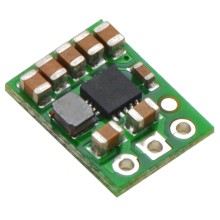Pololu 5V Step-Up/Step-Down Voltage Regulator S7V7F5
The S7V7F5 switching step-up/step-down regulator efficiently produces 5V from input voltages between 2.7V and 11.8V. Its ability to convert both higher and lower input voltages makes it useful for applications where the power supply voltage can vary greatly, as with batteries that start above but discharge below 5V. The very compact (0.35″×0.475″) module has a typical efficiency of over 90% and can supply up to 1A when stepping down and about 500mA when stepping up.
The Pololu step-up/step-down voltage regulator S7V7F5 is a switching regulator (also called a switched-mode power supply (SMPS) or DC-to-DC converter) that uses a buck-boost topology. It takes an input voltage from 2.7V to 11.8V and increases or decreases the voltage to a fixed 5V output with a typical efficiency of over 90%.
This flexibility in input voltage is especially well-suited for battery-powered applications in which the battery voltage begins above 5V and drops below as the battery discharges. Without the typical restriction on the battery voltage staying above the required voltage throughout its life, new battery packs and form factors can be considered. For instance, a 4-cell battery holder, which might have a 6V output with fresh alkalines but a 4.8V nominal voltage with NiMH cells and a 4.0V output with partially discharged cells, can now be used for a 5V circuit. In another typical scenario, a disposable 9V battery powering a 5V circuit can be discharged to under 3V instead of cutting out at 6V, as with typical linear or step-down regulators.
In typical applications, this regulator can deliver about 1A continuous when the input voltage is higher than 5V (stepping down) and 500mA continuous when the input is lower than 5V (stepping up); please see the graphs at the bottom of this page for a more detailed characterization. The regulator has short-circuit protection, and thermal shutdown prevents damage from overheating; the board does not have reverse-voltage protection.

For a similar regulator with an adjustable-output output, consider the step-up/step-down voltage regulator S7V8A.
For a higher-current alternative, consider the S911VF5, which can supply a typical maximum continuous current of 1.5A for input voltages close to 5V and offers a wider input voltage range of 2V to 16V, all in a smaller package. The S911VF5 is part of a larger S911Fx family of step-up/step-down regulators, which includes versions with precision-adjustable outputs and adjustable low-voltage cutoffs.
Features
- input voltage: 2.7Vto11.8V
- fixed 5V output with +5/-3% accuracy
- typical continuous output current: 1A when stepping down; 500mA when stepping up (Actual continuous output current depends on input voltage. See Typical Efficiency and Output Current section below for details.)
- power-saving feature maintains high efficiency at low currents (quiescent current is less than 0.1mA)
- integrated over-temperature and short-circuit protection
- small size: 0.35″×0.475″×0.1″ (9×12×3mm)
Dimensions
| Size: | 0.35″ × 0.475″ × 0.1″1 |
|---|---|
| Weight: | 0.4 g1 |
General specifications
| Minimum operating voltage: | 2.7 V |
|---|---|
| Maximum operating voltage: | 11.8 V |
| Maximum output current: | 1 A2 |
| Output voltage: | 5 V |
| Reverse voltage protection?: | N |
| Maximum quiescent current: | 0.1 mA3 |

